Exploring Bunk Beds: A Comprehensive Guide
Bunk beds have actually long been a staple in kids's bedrooms, dormitories, and even homes with minimal space. Not only do they provide a practical sleeping solution, but they also create a fun and imaginative environment for kids and a great space-saver for adults and households. This article will check out whatever you need to understand about bunk beds, from types and products to safety ideas and purchasing recommendations.
Tabulation
- Types of Bunk Beds
- Standard Bunk Beds
- Loft Beds
- Triple Bunk Beds
- L-Shaped Bunk Beds
- Product Options
- Wood
- Metal
- Safety Considerations
- Purchasing Guide
- Frequently asked questions
Types of Bunk Beds
Bunk beds are available in various styles to fit various needs and choices. Here's a breakdown of the most typical types:
Conventional Bunk Beds
Traditional bunks generally feature two beds stacked vertically on top of one another. These beds are ideal for brother or sisters sharing a room or for optimizing sleeping space in visitor spaces.
Loft Beds
Loft beds stand similarly to standard bunk beds but do not have a lower sleeping location. Instead, they frequently integrate a desk or seating location below, making them a great option for small spaces needing multifunctionality.
Triple Bunk Beds
Triple bunk beds are developed for three occupants, with beds stacked in a three-tier setup. These are less typical but can be an enjoyable option for large households or sleepovers.
L-Shaped Bunk Beds
With one bed placed horizontally and the other vertically, L-shaped bunk beds are typically geared up with extra functions such as desks or storage drawers and can complement corner areas in a space.
Comparison of Bunk Bed Types
| Bed Type | Ideal Use | Description |
|---|---|---|
| Conventional | Shared bed rooms or guest spaces | Two beds stacked vertically |
| Loft | Small spaces requiring multi-purpose space | Upper bed with open space below |
| Triple | Big families or pajama parties | Three beds stacked vertically |
| L-Shaped | Corner or flexible spaces | A combination of vertical and horizontal beds |
Product Options
Bunk beds are produced from various materials, with wood and metal being the most common. Each material has its benefits and drawbacks.
Wood
- Resilience: Generally robust and can withstand years of usage.
- Visual Appeal: Offers a timeless look that can mix with numerous decorations.
- Weight Capacity: Typically stronger; can support much heavier weights.
- Disadvantages: May be more expensive than metal choices and can be prone to scratches.
Metal
- Durability: Generally lightweight and easy to move however still durable.
- Modern Design: Often comes in smooth designs, making it appealing for modern spaces.
- Cost-efficient: Usually more economical than wood options.
- Disadvantages: Can be cold to the touch in winters and might not have the very same visual appeal for some purchasers.
Safety Considerations
When it concerns bunk beds, security can not be ignored. Here are key security pointers to keep in mind:
- Guardrails: Ensure that the top bunk has guardrails on both sides to avoid falls.
- Strong Construction: Check for a strong build and sturdy materials to stand up to weight and movement.
- Weight Limit: Adhere to the maker's weight limit for both the upper and lower bunks.
- Ladder Design: Choose bunks with a safe, easy-to-climb ladder and prevent any sharp edges or rungs.
- Age Restrictions: Most producers recommend that kids under the age of six should not oversleep the upper bunk.
Buying Guide
When shopping for bunk beds, think about the list below elements to discover the very best fit for your needs:
- Space Availability: Measure the space size and ceiling height, making sure there is appropriate space for the leading bunk.
- Bed Size: Decide in between twin, complete, or bigger sizes based upon your needs and the size of the space.
- Design Preference: Consider the general decoration of the bedroom to discover an ideal style.
- Relieve of Setup: Look for a bunk bed that is uncomplicated to put together.
- Budget plan: Bunk beds come in various cost varieties, so figure out a spending plan before starting your search.
Frequently asked questions
1. What is the advised age for kids to sleep on the leading bunk?
Children aged 6 and older are usually recommended to sleep on the top bunk to minimize the threat of falls.
2. How can I make my bunk bed safer?
To boost security, guarantee guardrails are correctly installed and examine that the bed is put on a flat surface area. Additionally, encourage kids to use the ladder thoroughly.
3. Can Bunk Beds Store transform a bunk bed into 2 separate beds?
Lots of bunk beds are designed to be convertible. Check the producer's requirements for convertibility functions.
4. What accessories are offered for bunk beds?
Typical devices include bed linens, storage drawers, staircases instead of ladders, and tented canopies for an enjoyable visual appeal.
5. How do I maintain my bunk bed?
Regular checks for loose screws or structural stability can help guarantee safety. Dust the bed regularly and tidy spills quickly to keep the materials in good condition.
Bunk beds are flexible and a space-efficient service for different living scenarios, from kids's spaces to guest accommodations. With numerous styles and materials available, possible buyers have a wealth of alternatives to think about, guaranteeing a mix of functionality and visual appeals. By focusing on security and following the ideas outlined in this guide, people can discover the ideal bunk bed that fits their space and lifestyle, all while creating an enjoyable sleeping environment.

